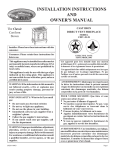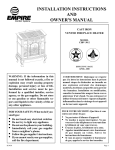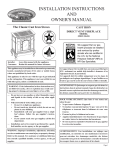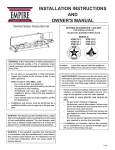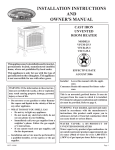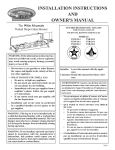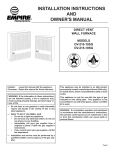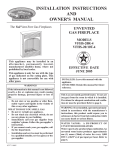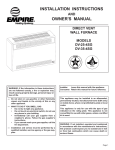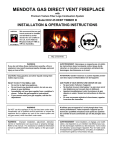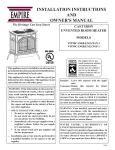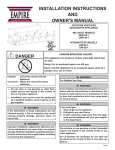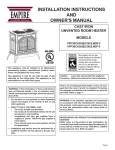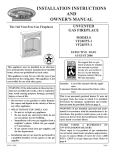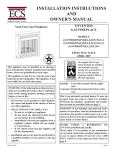Download White Mountain CIDV-30-20 Owner`s manual
Transcript
INSTALLATION INSTRUCTIONS AND OWNER'S MANUAL The Classic Cast Iron Stoves CAST IRON VENTED FIREPLACE HEATER MODEL CIBV-30-20 Installer: Leave this manual with the appliance. Consumer: Retain this manual for future reference. WARNING: If the information in these instructions are not followed exactly, a fire or explosion may result causing property damage, personal injury or loss of life. — Do not store or use gasoline or other flammable vapors and liquids in the vicinity of this or any other appliance. — WHAT TO DO IF YOU SMELL GAS • Do not try to light any appliance. • Do not touch any electrical switch; do not use any phone in your building. • Immediately call your gas supplier from a neighbor’s phone. Follow the gas supplier’s instructions. • If you cannot reach your gas supplier, call the fire department. — Installation and service must be performed by a qualified installer, service agency or the gas supplier. AVERTISSEMENT: Assurez vous de bien suivre les instructions données dans cette notice pour réduire au minimum le risque d’incendie ou d’explosion ou pour éviter tout dommage matériel, toute blessure ou la mort. — Ne pas entreposer ni utiliser d’essence ni d’autres vapeurs ou liquides inflammables dans le voisnage de cet appareil ou de tout autre appareil. — QUE FAIRE SI VOUS SENTEZ UNE ODEUR DE GAZ: • Ne pas tenter d’allumer d’appareil. • Ne touchez a aucun interrupteur. Ne pas vous servir des téléphones se trouvant dans le bâtiment où vous vous trouvez. • Appelez immédiatement votre fournisseur de gaz depuis un voisin. Suivez les instructions du fournisseur. • Si vous ne pouvez rejoindre le fournisseur de gaz, appelez le service des incendies. — L’installation et l’entretien doivent être assurés par un installateur ou un service d’entretien qualifié ou par le fournisseur de gaz. Page 1 TABLE OF CONTENTS SECTION PAGE Important Safety Information .................................................................................................3 Safety Information for Users of LP Gas .................................................................................4 Introduction ............................................................................................................................5 Specifications .........................................................................................................................6 Gas Supply .............................................................................................................................7 Clearances .............................................................................................................................8 Appliance Hardware Package ................................................................................................9 Assembly of Stove Casting .............................................................................................. 9-12 Optional Stone Inlay Installation..........................................................................................12 Wire Channel Installation .....................................................................................................13 Log Placement ......................................................................................................................13 Operating Guidelines............................................................................................................14 Vent Safety Shutoff System ..................................................................................................14 Venting .................................................................................................................................15 Lighting Instructions ...........................................................................................................16 Pilot Flame Characteristics...................................................................................................17 Main Burner Flame Characteristics......................................................................................17 Wiring ............................................................................................................................ 18-19 Maintenance ................................................................................................................... 19-20 Troubleshooting ................................................................................................................... 21 How To Order Repair Parts ..................................................................................................22 Parts List for CIBV-30-20 ...................................................................................................22 Parts View for CIBV-30-20 ................................................................................................23 Parts List for Stove Casting ..................................................................................................24 Parts View for Stove Casting................................................................................................25 Optional Blower Installation Instructions ..................................................................... 26-27 Page 2 15627-5-0807 IMPORTANT SAFETY INFORMATION THIS IS A HEATING APPLIANCE DO NOT OPERATE THIS APPLIANCE WITHOUT FRONT PANEL INSTALLED. • Due to high temperatures, the fireplace heater should be located out of traffic and away from furniture and draperies. • Children and adults should be alerted to the hazards of high surface temperature and should stay away to avoid burns or clothing ignition. • Young children should be carefully supervised when they are in the same room as the fireplace heater. • Clothing or other flammable material should not be placed on or near the fireplace heater. • Surveiller les enfants. Garder les vêtements, les meubles, l'essence ou autres liquides à vapeur inflammables lin de l'appareil. • Due to high surface temperatures, keep children, clothing and furniture away. • The glass front or any part removed for servicing the appliance must be replaced prior to operating the appliance. Work should be done by a qualified service person. • Keep burner and control compartment clean. • Installation and repair should be done by a QUALIFIED SERVICE PERSON. The fireplace heater should be inspected before use and at least annually by a qualified service person. More frequent cleaning may be required due to excessive lint from carpeting, bedding material, etc. It is imperative that control compartments, burners and circulating air passageways of the fireplace heater be kept clean. • S'assurer que le brûleur et le compartiment des commandes sont propres. Voir les instructions d'installation et d'utilisation qui accompagnent l'appareil. • DO examine burners periodically. Clean and replace damaged parts. • CAUTION: The glass used in your heater is a special high temperature ceramic glass. If the glass is cracked or damaged in any way, it should be replaced only with a complete glass frame assembly from Empire. See parts list on Page 22 for ordering. • DO NOT use this heater if any part has been under water. Immediately call a qualified service technician to inspect the heater and to replace any part of the control system and any gas control which has been under water. • Ne pas se servir de cet appareil s'il a été plongé dans l'eau, complètement ou en partie. Appeler un technicien qualifié pour inspecter l'appareil et remplacer toute partie du système de contrôle et toute commande qui ont été plongés dans l'eau. • Under no circumstances should any solid fuels (wood, coal, paper or cardboard etc.) be used in this appliance. • WARNING: Any change to this fireplace heater or its controls can be dangerous. Any safety screen or guard removed for servicing a fireplace heater must be replaced prior to operating the fireplace heater • WARNING: If not installed, operated and maintained in accordance with the manufacturer's instructions, this product could expose you to substances in fuel or from fuel combustion which can cause death or serious illness. • WARNING: Do not operate appliance with the glass front removed, cracked or broken. Replacement of the glass should be done by a licensed or qualified service person. • DO keep the appliance area clear and free from combustible material, gasoline and other flammable vapors and liquids. 15627-5-0807 Page 3 SAFETY INFORMATION FOR USERS OF LP-GAS Propane (LP-Gas) is a flammable gas which can cause fires and explosions. In its natural state, propane is odorless and colorless. You may not know all the following safety precautions which can protect both you and your family from an accident. Read them carefully now, then review them point by point with the members of your household. Someday when there may not be a minute to lose, everyone's safety will depend on knowing exactly what to do. If, after reading the following information, you feel you still need more information, please contact your gas supplier. LP-GAS WARNING ODOR If a gas leak happens, you should be able to smell the gas because of the odorant put in the LP-Gas. That's your signal to go into immediate action! • • • • Do not operate electric switches, light matches, use your phone. Do not do anything that could ignite the gas. Get everyone out of the building, vehicle, trailer, or area. Do that IMMEDIATELY. Close all gas tank or cylinder supply valves. LP-Gas is heavier than air and may settle in low areas such as basements. When you have reason to suspect a gas leak, keep out of basements and other low areas. Stay out until firefighters declare them to be safe. • • Use your neighbor's phone and call a trained LP-Gas service person and the fire department. Even though you may not continue to smell gas, do not turn on the gas again. Do not re-enter the building, vehicle, trailer, or area. Finally, let the service man and firefighters check for escaped gas. Have them air out the area before you return. Properly trained LP-Gas service people should repair the leak, then check and relight the gas appliance for you. NO ODOR DETECTED - ODOR FADE Some people cannot smell well. Some people cannot smell the odor of the chemical put into the gas. You must find out if you can smell the odorant in propane. Smoking can decrease your ability to smell. Being around an odor for a time can affect your sensitivity or ability to detect that odor. Sometimes other odors in the area mask the gas odor. People may not smell the gas odor or their minds are on something else. Thinking about smelling a gas odor can make it easier to smell. The odorant in LP-gas is colorless, and it can fade under some circumstances. For example, if there is an underground leak, the movement of the gas through soil can filter the odorant. Odorants in LP-Gas also are subject to oxidation. This fading can occur if there is rust inside the storage tank or in iron gas pipes. The odorant in escaped gas can adsorb or absorb onto or into walls, masonry and other materials and fabrics in a room. That will take some of the odorant out of the gas, reducing its odor intensity. LP-Gas may stratify in a closed area, and the odor intensity could vary at different levels. Since it is heavier than air, there may be more odor at lower levels. Always be sensitive to the slightest gas odor. If you detect any odor, treat it as a serious leak. Immediately go into action as instructed earlier. SOME POINTS TO REMEMBER • Learn to recognize the odor of LP-gas. Your local LP-Gas Dealer can give you a "Scratch and Sniff" pamphlet. Use it to find out what the propane odor smells like. If you suspect that your LP-Gas has a weak or abnormal odor, call your LP-Gas Dealer. • If you are not qualified, do not light pilot lights, perform service, or make adjustments to appliances on the LP-Gas system. If you are qualified, consciously think about the odor of LP-Gas prior to and while lighting pilot lights or performing service or making adjustments. • Sometimes a basement or a closed-up house has a musty smell that can cover up the LP-Gas odor. Do not try to light pilot lights, perform service, or make adjustments in an area where the conditions are such that you may not detect the odor if there has been a leak of LP-Gas. • Odor fade, due to oxidation by rust or adsorption on walls of new cylinders and tanks, is possible. Therefore, people should be particularly alert and careful when new tanks or cylinders are placed in service. Odor fade can occur in new tanks, or reinstalled old tanks, if they are filled and allowed to set too long before refilling. Cylinders and tanks which Page 4 have been out of service for a time may develop internal rust which will cause odor fade. If such conditions are suspected to exist, a periodic sniff test of the gas is advisable. If you have any question about the gas odor, call your LP-gas dealer. A periodic sniff test of the LP-gas is a good safety measure under any condition. • If, at any time, you do not smell the LP-Gas odorant and you think you should, assume you have a leak. Then take the same immediate action recommended above for the occasion when you do detect the odorized LP-Gas. • If you experience a complete "gas out," (the container is under no vapor pressure), turn the tank valve off immediately. If the container valve is left on, the container may draw in some air through openings such as pilot light orifices. If this occurs, some new internal rusting could occur. If the valve is left open, then treat the container as a new tank. Always be sure your container is under vapor pressure by turning it off at the container before it goes completely empty or having it refilled before it is completely empty. 15627-5-0807 INTRODUCTION Introduction Always consult your local Building Department regarding regulations, codes or ordinances which apply to the installation of a vented fireplace heater. Instructions to Installer 1. Installer must leave instruction manual with owner after installation. 2. Installer must have owner fill out and mail warranty card supplied with heater. 3. Installer should show owner how to start and operate heater and thermostat. General Information This appliance is design certified in accordance with American National Standard /CSA Standard ANSI Z21.88 and CSA 2.33 by the Canadian Standards Association, as a Vented Fireplace Heater and must be installed according to these instructions. Any alteration of the original design, installed other than as shown in these instructions or use with a type of gas not shown on the rating plate is the responsibility of the person and company making the change. Important All correspondence should refer to complete Model Number, Serial Number and type of gas. Notice: During initial firing of this unit, its paint will bake out and smoke will occur. To prevent triggering of smoke alarms, ventilate the room in which the unit is installed. Qualified Installing Agency Installation and replacement of gas piping, gas utilization equipment or accessories and repair and servicing of equipment shall be performed only by a qualified agency. The term "qualified agency" means any individual, firm, corporation or company which either in person or through a representative is engaged in and is responsible for (a) the installation or replacement of gas piping or (b) the connection, installation, repair or servicing of equipment, who is experienced in such work, familiar with all precautions required and has complied with all the requirements of the authority having jurisdiction. State of Massachusetts: The installation must be made by a licensed plumber or gas fitter in the Commonwealth of Massachusetts. The installation must conform with local codes or, in the absence of local codes, with the National Fuel Gas Code, ANSI Z223.1/ NFPA 54.* High Altitudes When installing this unit at an elevation above 2000 feet (in the United States) it may be necessary to decrease the input rating by changing the existing burner orifice to a smaller size. Generally, input should be reduced 4 percent for each 1000 feet above sea level. However, if the heating value of the gas has been reduced, this general rule may not apply. Check with local gas utility for proper orifice size identification. APPLIES TO CANADIAN MODELS ONLY FOR PROPANE GAS. Altitude: 0-4,500 feet (0-1370 m) without orifice change. APPLIES TO CANADIAN MODELS ONLY FOR NATURAL GAS. Altitude 0-2,000 feet (0-610m) without orifice change. Cet appareil est équipé pour des altitudes compris entre 0 et 2000 pieds (0-610m) seulement. For installations from 610-1370 metres (2,000-4,500 ft.) the orifice size (DMS) for natural gas is 39. See data plate for additional information. For high altitude installations consult the local gas distributor or the authority having jurisdiction for proper rating methods. If the installer must convert the unit to adjust for varying altitudes, the information sticker (illustrated below) must be filled out by the installer and adhered to the appliance at the time of conversion. THE CONVERSION SHALL BE CARRIED OUT BY A MANUFACTURER'S AUTHORIZED REPRESENTATIVE IN ACCORDANCE WITH THE REQUIREMENTS OF THE MANUFACTURER, PROVINCIAL OR TERRITORIALAUTHORITIES HAVING JURISDICTION AND IN ACCORDANCE WITH THE REQUIREMENTS OF THE CAN/CGA-B141.1 OR CAN/CGAB141.2 INSTALLATION CODES. LA CONVERSION DOIT ÊTRE EFFECTUÉE CONFORMÉMENT AUX RÉGLEMENTATION PROVINCIAUX EN CAUSE ET AUX EXIGENCES DES CODES D'INSTALLATION CAN/CGA-B149. This appliance has been converted for use at an altitude of Orifice size Manifold Pressure Input (Btu/h) Fuel Type Date of Conversion Converted by Cet appareil a été converti au Injecteur Pression à la tubulure d'alimentation Déoit calorifique *Available from the American National Standards Institute, Inc., 11 West 42nd St., New York, N.Y. 10036. 15627-5-0807 Page 5 SPECIFICATIONS Model Input BTU/HR (KW/H) Maximum BTU/HR (KW/H) Minimum Height Width Depth including diverter Gas Inlet Size Draft Diverter Collar Floor to top of collar on vertical position of Draft Diverter Floor to center of collar on horizontal position of Draft Diverter Stove Casting (Must be ordered with Firebox) CIFB-1 CIPB-1 CIPG-1 CIPS-1 CIPN-1 CIPR-1 Accessories TMV FRBC-1 FRBTC-1 FREC-1 FWS-1 CIB-2 Stone Inlay Replaces Standard Grill Top CII-2 Stone Inlay CII-3 Stone Inlay CII-4 Stone Inlay CII-5 Stone Inlay CII-6 Stone Inlay CII-7 Stone Inlay Page 6 CIBV-30 30,000 (8.7) 21,000 (6.2) 27 3/4" (704mm) 25 `/1" (647mm) 21" (533mm) 1/2" (13mm) 4" (101mm) 27 3/8" (695mm) 23 1/2" (596mm) Flat Black Porcelain Black Porcelain Green Porcelain Sand Porcelain Navy Porcelain Red Millivolt Wall Thermostat - Reed Switch Battery Operated Remote Control Battery Operated Remote Control w/Thermostat Electric Remote Control Wall Switch Automatic Blower Empress Green Hunan Jade Gray Botticino Azul Salome Black Swan 15627-5-0807 GAS SUPPLY Consult the current National Fuel Gas Code, ANSI Z223.1 CAN/ CGA-B149 (.1 or .2) installation code. Recommended Gas Pipe Diameter Pipe Length Schedule 40 Pipe Tubing, Type L Inside Diameter Outside Diameter Nat. L.P. Nat. L.P. 0-10 feet 1/2” 3/8” 1/2” 3/8” 0-3 meters 12.7mm 9.5mm 12.7mm 9.5mm 10-40 feet 1/2” 1/2” 5/8” 1/2” 4-12 meters 12.7mm 12.7mm 15.9mm 12.7mm 40-100 feet 1/2” 1/2” 3/4” 1/2” 13-30 meters 12.7mm 12.7mm 19mm 12.7mm 100-150 feet 3/4” 1/2” 7/8” 3/4” 31-46 meters 19mm 12.7mm 22.2mm 19mm Note: Never use plastic pipe. Check to confirm whether your local codes allow copper tubing or galvanized. Note: Since some municipalities have additional local codes, it is always best to consult your local authority and installation code. The use of the following gas connectors is recommended: — ANS Z21.24 Appliance Connectors of Corrugated Metal Tubing and Fittings — ANS Z21.45 Assembled Flexible Appliance Connectors of Other Than All-Metal Construction The above connectors may be used if acceptable by the authority having jurisdiction. The state of Massachusetts requires that a flexible appliance connector cannot exceed three feet in length. Installing a New Main Gas Cock Each appliance should have its own manual gas cock. A manual main gas cock should be located in the vicinity of the unit. Where none exists, or where its size or location is not adequate, contact your local authorized installer for installation or relocation. Compounds used on threaded joints of gas piping shall be resistant to the action of liquefied petroleum gases. The gas lines must be checked for leaks by the installer. This should be done with a soap solution watching for bubbles on all exposed connections, and if unexposed, a pressure test should be made. Never use an exposed flame to check for leaks. Appliance must be disconnected from piping at inlet of control valve and pipe capped or plugged for pressure test. Never pressure test with appliance connected; control valve will sustain damage! NOTE: The gas control is equipped with a captured screw type pressure test point, therefore it is not necessary to provide a 1/8" test point up stream of the control. A gas valve and ground joint union should be installed in the gas line upstream of the gas control to aid in servicing. It is required by the National Fuel Gas Code that a drip line be installed near the gas inlet. This should consist of a vertical length of pipe tee connected into the gas line that is capped on the bottom in which condensation and foreign particles may collect. When using copper or flex connector use only approved fittings. Always provide a union so that gas line can be easily disconnected for burner servicing. The appliance and it's individual shut off valve must be disconnected from supply piping system during any pressure testing of that system at test pressures in excess of 1/2 psig (3.5kPa). The appliance must be isolated from the gas supply piping system by closing its individual manual shut off valve during any pressure testing of the gas supply piping system at test pressures equal to or less than 1/2 psig (3.5kPa). Attention! If one of the procedures results in pressures in excess of 1/2 psig (14" w.c.) (3.5 kPa) on the fireplace gas valve, it will result in a hazardous condition. Figure 1 15627-5-0807 Checking Manifold Pressure Both Propane and Natural gas valves have a built-in pressure regulator in the gas valve. Natural gas models will have a manifold pressure of approximately 3.5" w.c. (.871kPa) for maximum input or 1.7" w.c. (.423kPa) for minimum input at the valve outlet with the inlet pressure to the valve from a minimum of 5.0" w.c. (1.245kPa) for the purpose of input adjustment to a maximum of 10.5" (2.615kPa) w.c. Propane gas models will have a manifold pressure approximately 10.0"w.c. (2.49kPa) for maximum input or 5.9" w.c. (1.469kPa) for minimum input at the valve outlet with the inlet pressure to the valve from a minimum of 11.0" w.c. (2.739kPa) for the purpose of input adjustment to a maximum of 13.0" w.c. (3.237kPa). A 1/8" (3mm) N.P.T. plugged tapping, accessible for test gauge connection, is located on the outlet side of the gas control. Page 7 CLEARANCES Clearances: When facing the front of the fireplace heater the minimum clearances to combustible construction (material) are the following: Open in front to provide service, access, and clearance to construction. Top of appliance (ceiling) 36 (inches) Draft Diverter to Rear Wall 2 (inches) Side Wall 6 (inches) Heater Corners (45° angle) to Wall 4 (inches) Floor 0 (inches) Installation on Rugs and Tile If this appliance is to be installed directly on carpeting, tile, or other combustible material, other than wood flooring, the appliance shall be installed on a metal or wood panel extending the full width and depth of the appliance. The base referred to above does not mean the fire-proof base as used on wood stoves. The protection is primarily for rugs that may be extremely thick and light-color tile that can discolor. (914mm) TO CEILING OR HORIZONTAL PROJECTION ABOVE APPLIANCE Figure 3 Figure 2 Figure 4 Page 8 15627-5-0807 APPLIANCE HARDWARE PACKAGE Appliance Hardware Package Parts List Part Description Part Number Quantity Supplied 1/42-0 x 1" Phillips Head Bolt R-3188 4 1/4-20 x 3/8" Phillips Head Bolt R-3646 16 1/4-20 x 1/2" Leveling Bolt R-3747 4 No. 10 x 1/2" Hex Washer Head Screw R-2737 10 1/4-20 Washer Head Nut R-3185 4 Leg Pad "A" (see Figure 6) CI-008 2 Leg Pad "B" (see Figure 6) CI-009 2 1-1/4" x 1/2" Retaining Tab (see Figure 8) CI-007 4 1/4" x 9/32 Washer (Not Shown) R-1150 8 Figure 5 ASSEMBLY OF STOVE CASTING Assembly of Stove Casting (Figures 6, 7, 8, 9, 10, 11 and 12) Attention: Included in the hardware package are (8) 1/4" inside diameter washers. A 1/4" washer may be used with a 1/4-20 x 3/8" bolt when assembling the stove casting parts. If a bolt hole is not tapped deep enough for a tight fit between stove casting parts, the 1/4" washer can be used as a shim to provide a tight fit. The 1/4" washers are not required for assembly of the stove casting if all the bolt holes are tapped to a proper depth. Additonal 1/4" washers are to be purchased locally. 1. Place porcelain casting pieces on a non-abrasive surface in order to protect the porcelain finish. The exterior of the porcelain casting pieces should be facing the non-abrasive surface. 2. The assembly of the casting is accomplished in 7 stages: A. Attaching legs to the sides (Figure 6). B. Attaching rear cover to sides (Figure 7). C. Removing protective packaging from casting front and window (Figure 8). D. Assembly of front by attaching retaining tabs and placing front on unit (Figure 9). 15627-5-0807 E. Inserting firebox into partially completed assembly (Figure 10 and Figure 11). F. Attaching firebox to rear cover (Figure 12). G. Placing top on unit. Detailed Instructions Follow 3. Refer to Figure 6, the leg pads will have the letter "A" and "B" stamped into the metal. Place leg pad "A" and leg pad "B" at the bottom of each casting side. Leg pad "A" attaches to the front of the casting side, right and to the rear of the casting side, left. Leg pad "B" attaches to the rear of the casting side, right and to the front of the casting side, left. Position the 3/4" flange on the leg pad against the (2) locator dimples on the casting side. The 3/4" flange must be facing upward, toward the top louver openings on the casting side. Attach the two rear leg pads to the casting sides with (2) 3/8" bolts. Attach but do not completely tighten the two front leg pads to the casting sides with (2) 3/8" bolts. Attention: The front leg pads can be adjusted to provide a snug fit between the casting front and the casting sides. 4. Attach (4) leveling bolts to the bottom of the (4) legs. Page 9 ASSEMBLY OF STOVE CASTING Figure 6 5. Align the 3/8" hole at the top of the leg with the 3/8" hole in the leg pad. Attention: For proper positioning of the leg to the leg pad the (2) 1-1/2" top edges of the leg must be placed flush and parallel to the (2) edges on the leg pad. Attach leg to leg pad by inserting (1) 1" bolt through the leg pad and into the leg, secure bolt with 1/4" nut. 6. Insert (2) 3/8" bolts into the (2) holes on the edges of the casting sides. The bolts should only be threaded half-way into the holes in order to allow for clearance when the casting back is attached to the casting sides. 7. Refer to Figure 7, the rear cover has (4) keyholes for attachment to the casting sides. Stand the casting sides on the floor with the (2) bolts attached half-way into the edges of the rear cover positioned at the rear. The large diameter holes in the keyholes of the rear cover will be toward the floor. Working with one casting side at a time, place the large diameter holes in the keyholes over and behind both of the bolts at the same time. Push downward on the rear cover to lock the keyholes into position behind the bolts. Finish tightening both bolts to secure rear cover to casting side. Repeat this procedure to secure rear cover to the second casting side. Figure 7 Page 10 15627-5-0807 Figure 8 8. Position the completed portion of the casting in the approximate location for installation as the completed assembly will be heavy. 9. Refer to Figure 8, remove protective packing foam from casting front and window. Remove the (1) 3/4" bolt and (1) 1/4" washer from top of window. Remove (1) 3/8" bolt and 1 - 5/8" x 3/4" retaining tab from bottom of window. Remove the window from casting front. Remove the protective sheet of foam from the casting front. Place the window into the casting front. Attach the top of the window to the casting front with (1) 1/4" washer and (1) 3/4" bolt. Place the 1 -5/8" x 3/4" retaining tab into the locator notch on the bottom of the casting front. Attach the bottom of the window to the casting front by inserting (1) 3/8" bolt through retaining tab and into locator notch. 10. Refer to Figure 8, attach the (4) 1-1/4" x 1/2" retaining tabs to the casting front with (4) 3/8" bolts. The retaining tabs should be positioned downward, from the casting front, top to the casting front, bottom. 11. Refer to Figure 9, attach casting front to casting by using the (4) retaining tabs on the casting front. The (2) top, retaining tabs on the casting front will be placed behind the (2) top, locator tabs on the front of the casting sides. The (2) bottom, retaining tabs will be inserted into the (2) 9/16" slots on the front, leg pads. Place the top, retaining tabs behind the top, locator tabs as you pivot inward the bottom of the casting front order to insert the bottom, retaining tabs into the slots. 15627-5-0807 Figure 9 Page 11 ASSEMBLY OF STOVE CASTING (continued) 12. The following procedure will provide a snug fit between the casting front and the casting sides. Grasp the right, front leg, push inward on the leg in order to provide a snug fit between the casting front and the casting side. Continue to hold the right, front leg as you completely tighten the (2) 3/8" bolts that attach the leg pad to the right, casting side. Repeat procedure for left, front leg to achieve a snug fit between the casting front and the casting side. 13. Remove the casting front from the casting. 14. Refer to Figures 10 and 11, the appliance firebox can now be inserted into the casting. Center the firebox in the casting. Attention: Remove (1) Phillips-head screw in the top of the valve cover. The screw is used to secure the valve cover in place during shipping. The (1) Phillips-head screw can be discarded. 15. Refer to Figure 12, align (4) clearance holes on rear cover with screw holes in (2) upper mounting brackets and diverter back assembly. Attach firebox to rear cover with (4) 10 x 1/2" screws. 16. Attach casting front to casting as described in Step 11. 17. Place the casting top onto the casting. The casting top nests into the casting. 18. Insert center grill, left grill and right grill into casting top. 19. Level appliance by adjusting leveling bolts. 20. Assembly of stove casting is completed. Figure 10 Figure 11 OPTIONAL STONE INLAY INSTALLATION Whenever the standard grill top is replaced with a stone inlay you must install the top shield and heat shield, which are provided with the stone inlay. Installation of Optional Stone Inlay 1. Remove left grill, center grill and right grill from casting top. 2. Remove casting top from outer casting. 3. Place the casting top on a non-abrasive surface in order to protect the porcelain finish. The exterior of the casting top should be facing the non-abrasive surface. 4. Attach 11 5/8" x 11 5/8" top shield to the interior of the casting top with (1) 3/8" bolt provided in hardware package. 5. Remove the (2) 1/2" hex-head screws located on the front of the heat exchanger top. The screws are 8 3/4" apart. Do not remove the center hex-head screw. Remove the (2) screw hole, knockouts located on the back of the heat exchanger top. The knockouts are 8 3/4" apart. Position the angled front on the 12" Page 12 x 19 3/8" heat shield with the front of the appliance. Align the (4) tabs with clearance holes on the 12" x 19 3/8" heat shield with the (4) screw holes on the heat exchanger top. Attach the 12" x 19 3/8" heat shield to the heat exchanger top with (2) 1/2" hex-head screws removed in Step 5 and (2) 1/2" hex-head screws provided in hardware package. 6. Place the casting top onto the casting. The casting top nests into the casting. 7. Insert center stone inlay, left stone inlay and right stone inlay into casting top. 8. Installation of stone inlay is completed. Parts List Part Description Part Number Quantity Supplied CI-091 1 12" x 19 3/8" Heat Shield CI-092 1 3/8" Bolt R-3646 1 1/2" Hex-Head Screw R-2737 4 11 5/8" x 11 5/8" Top Shield 15627-5-0807 WIRE CHANNEL INSTALLATION The ON/OFF/REMOTE switch with harness is factory installed into the switch box. After the appliance housing is installed into the casting the wire channel can be installed. 1. Attach switch box on the left side of rear cover with (2) 10 x 1/2" screws. 2. Route wires from ON/OFF/REMOTE switch within wire channel. 3. Attach wire channel on the left side of the rear cover with (4) 10 x 1/2" screws. 4. Attach the black and green (wires) female pushons to the TH/TP and TH (two outside male tabs) terminals on gas valve. 5. Identify vent safety switch wire harness. The first wire is installed into magnet section on gas valve. The second wire is attached to the TH/TP terminal on gas valve. Route opposite end of vent safety switch wire harness within (2) metal clips on exterior of rear cover. Attach (2) 1/4" female push-ons on vent safety switch wire harness onto (2) 1/4" male tabs on vent safety switch which is located on the side of draft diverter. Figure 12 LOG PLACEMENT 1. Lower valve cover on firebox. 2. Release two door latches at bottom of firebox. 3. Grasp bottom of glass frame, lift glass frame upward in order to release glass frame from lip on top of firebox. 4. Remove logs from interior of firebox. Remove all protective packaging from logs and interior of firebox. 5. Place front log onto two (2) front pins on inner bottom. 6. Place rear log onto two (2) rear pins on rear log support. 7. Place top log onto two (2) pins on rear log. 8. Align and place top of glass frame over lip on top of firebox. Grasp bottom of glass frame, push inward and place glass frame onto firebox. 9. Attach two door latches to bottom of firebox. 10. Log placement is completed. Refer to Figure 13 for the following warning. Warning: Failure to position the parts in accordance with this diagram or failure to use only parts specifically approved with this appliance may result in property damage or personal injury. Avertissement: Risque de dommages ou de blessures si les pièces ne sont pas installées conformément à ce schéma et ou si de pièces autres que celles spécifiquement approuvées avec cet appareil sont utilisées. Figure 13 15627-5-0807 Page 13 OPERATING GUIDELINES Before operating this heater, please review the safety warnings pages at the beginning of this manual and those precautions and warnings listed below. 1. Know what type of ignition system this model has (standing pilot) and follow the applicable SAFETY and LIGHTING instructions. 2. Check to ensure there are no gas leaks. If you are unsure, turn gas off to the heater and call a service person or your gas utility. CAUTION: Clothing or other flammable material should not be placed on or near the appliance. WARNING: Children and adults should be alerted to the hazard of high surface temperature and should stay away to avoid burns or clothing ignition. Young children should be carefully supervised when they are in the same room as the appliance. 3. Tampering is DANGEROUS and voids all warranties. Any component that is found to be faulty, must be replaced with an approved component. Initial Lighting (Figure 14) Upon completing the gas line or turning the gas valve "ON" after it has been in the "OFF" position, a small amount of air will be in the lines. When first lighting the appliance, it will take a few minutes for the lines to purge themselves of this air. Once the purging is complete, the appliance will light and operate satisfactorily. Subsequent lightings of the appliance will not require such purging if the gas valve is not turned to "OFF." Standing Pilot Operation 1. Follow the SAFETY and LIGHTING INSTRUCTIONS for standing pilot controls found in this manual and on labels found attached to the appliance. CAUTION: During the initial purging and subsequent lightings, never allow the gas valve control knob to remain depressed in the "pilot" position without pushing the piezo ignitor button at least once every second. 2. During the heating season, leave the control valve knob in the "ON" position. This will allow the pilot flame to remain lit. Turn the burner flame on or off with the appliance ON/OFF rocker switch, wall switch, remote control kits or 750 millivolt wall thermostat. NOTE: The gas control valve allows you to increase or decrease the height of the main burner flame. The control valve has a pressure regulator with a knob as shown in Figure 14. Rotate the knob clockwise to "HI" to increase the flame height and counterclockwise to "LO" to decrease the flame height. 3. When the heating season is over, turn the on/off switch to "OFF" and the control valve to "OFF". The system, including the pilot light, will be shut down. Figure 14 Maximum and Minimum Input The gas valve on the appliance allows the input to adjust between a maximum input of 30,000 to a minimum input of 21,000 Btuh. Please be advised, the maximum input provides the greatest amount of yellow flame and ember glow on the log set. The minimum input substantially decreases the yellow flame and ember glow on the log set. VENT SAFETY SHUTOFF SYSTEM This heater must be properly connected to a venting system. This heater is equipped with a vent safety shutoff system. Warning: Operation of this heater, when not connected to a properly installed and maintained venting system or tampering with the vent safety shutoff system, can result in carbon monoxide (CO) poisoning and possible death. This appliance needs fresh air for safe operation and must be installed so there are provisions for adequate combustion and ventilation air. Reversible Vertical or Horizontal Draft Diverter This fireplace heater has a reversible draft diverter. The draft diverter is installed in the vertical position at the factory. Please use the following steps to change the draft diverter from the vertical position to the horizontal position. 1. Remove (8) hex-head screws located adjacent to the flue collar on the draft diverter. 2. Rotate flue collar to the horizontal position on the draft diverter. 3. Attach flue collar to draft diverter with (8) hex-head screws from Step 1. This fireplace heater is equipped with a vent safety switch. The vent safety switch will cause gas flow to the pilot to "shut off" due to improper venting or a blocked flue. If the vent safety switch continues to "shut off" the gas flow to the pilot a qualified service person must be contacted to inspect for improper venting, blockage in the vent pipe or the vent safety switch for being defective. Page 14 15627-5-0807 VENTING Venting 1. Flue pipe must be as large as the flue collar on the draft diverter. 2. Maintain an upward slope of at least 1/4 inch (6mm) per foot of horizontal run. 3. Run flue pipe as directly as possible with a minimum of elbows. 4. Flue pipe should extend through the wall of a chimney to be flush with inner wall. 5. Flue pipe must be adequately supported by metal straps. 6. Single wall vent pipe may be attached directly to the draft hood of the fireplace heater when a clearance of 2 1/2 inches (64mm) is maintained between the single wall vent pipe and the combustible wall of the room in which the fireplace heater is located. Use double wall vent pipe for clearances less than 2 1/2 inches (64mm) to combustibles. 7. For flue pipe running through walls and roof, use B-1 [1 inch (25mm) clearance to combustibles] vent pipe. 8. Chimneys should extend at least 2 feet (.6m) above the roof and above any object or nearby building within 10 feet (3m). 9. Open tees should not be used in the flue pipe. 10. Appliance must not be connected to a chimney flue that is servicing a separate solid-fuel burning appliance. For proper venting, do not attach a 90° elbow directly to draft diverter. If possible, attach 2 feet (.6m) of straight vent pipe before an elbow is used. Use of 45° elbows is recommended. zone as the combustion air inlet to the appliance and shall be so located so that the relief opening is accessible for checking vent operation. Liner and Insulated Liner When you install a vented fireplace heater into a masonry chimney you must follow these steps. 1. The chimney must be lined and sized properly. Most masonry chimneys are over sized and absorb too much heat to be considered a proper vent. If you have any doubts line the chimney with the right size liner. If it's unlined you must line it. 2. Use an insulated liner when the chimney is on the outside, three sides exposed to the weather, and there is no clay liner in the chimney. The insulation will help keep the flue gases warmer. Insulated Vent Enclosure (Figure 15) Vented fireplace heaters installed with the vent going directly to the outside and above the eaves can cause poor venting. The cold pipe will have a delay in proper venting and cause the fireplace heater to shut "off" by the vent safety switch. To prevent delayed venting as well as condensation of flue products an insulated enclosure is recommended. Use type B 4" (102mm) diameter vent pipe and maintain at least a one inch (25mm) clearance to combustibles. Use metal thimble to protect vent pipe as it passes through combustibles Uninsulated single-wall metal pipe shall not be used outdoors in cold climates for venting gas utilization equipment. Ventilation and Combustion Air Fireplace heaters shall be installed in a location in which the facilities for ventilation permit satisfactory combustion of gas and proper venting under normal conditions. In buildings of conventional frame, brick or stone construction without tight storm windows and doors, infiltration is normally adequate to provide for combustion and draft hood dilution. Where appliances are installed in a confined space within a building, the building being of unusually tight construction, air for combustion and ventilation must be obtained directly from outdoors or from such spaces that freely communicate with the outdoors. Under these conditions, the confined space shall be provided with two permanent openings, one near the top of the enclosure and one near the bottom; each opening shall have a free area of not less than one square inch (6.5cm2) per 1,000 BTU's (.3KW) of total input. The draft hood must be in the same atmospheric pressure . Figure 15 15627-5-0807 Page 15 LIGHTING INSTRUCTIONS FOR YOUR SAFETY READ BEFORE LIGHTING WARNING: If you do not follow these instructions exactly, a fire or explosion may result causing property damage, personal injury or loss of life. A. This appliance has a pilot which must be lighted by hand. When lighting the pilot, follow these instructions exactly. B. BEFORE LIGHTING smell all around the appliance area for gas. Be sure to smell next to the floor because some gas is heavier than air and will settle on the floor. WHAT TO DO IF YOU SMELL GAS • Do not try to light any appliance. • Do not touch any electrical switch; do not use any phone in your building. • Immediately call your gas supplier from a neighbor's phone. Follow the gas supplier's instructions. • If you cannot reach your gas supplier, call the fire department. C. Use only your hand to push in or turn the gas control knob. Never use tools. If the knob will not push in or turn by hand, don't try to repair it; call a qualified service technician. Force or attempted repair may result in a fire or explosion. D. Do not use this appliance if any part has been under water. Immediately call a qualified service technician to inspect the appliance and to replace any part of the control system and any gas control which has been under water. LIGHTING INSTRUCTIONS 1. STOP! Read the safety information above. 2. Set the thermostat to lowest setting. 3. Turn off all electric power to the appliance (if applicable). 4. Lower valve cover. 5. Push in gas control knob slightly and turn clockwise to "OFF". 8. Turn knob on gas control counterclockwise to "PILOT." 9. Push in gas control knob all the way and hold in. Repeatedly push the piezo ignitor button until pilot is lit. Continue to hold the control knob in for about one (1) minute after the pilot is lit. Release knob and it will pop back up. Pilot should remain lit. If it goes out, repeat steps 5 through 9. • If knob does not pop up when released, stop and immediately call your service technician or gas supplier. 6. Wait ten (10) minutes to clear out any gas. Then smell for gas, including near the floor. If you smell gas, STOP! Follow "B" in the safety information above. If you don't smell gas, go to the next step. 7. Find pilot - The pilot is attached to the main burner behind the front log. • If the pilot will not stay lit after several tries, turn the gas control knob to "OFF" and call your service technician or gas supplier. 10. Turn gas control knob counterclockwise "ON". to 11. Raise valve cover. 12. Turn on all electric power to the appliance (if applicable). 13. Set thermostat to desired setting. TO TURN OFF GAS TO APPLIANCE 1. 2. 3. Set the thermostat to lowest setting. Turn off all electric power to appliance if service is to be performed (if applicable). Lower valve cover. Page 16 4. 5. Push in gas control knob slightly and turn clockwise to "OFF". Do not force. Raise valve cover. 15627-5-0807 PILOT FLAME CHARACTERISTICS Figure 16 shows a correct pilot flame pattern. The correct flame will be blue and will extend beyond the thermopile. The flame will surround the thermopile just below the tip. A slight yellow flame may occur where the pilot flame and main burner flame meet. Figure 17 shows an incorrect pilot flame pattern. The incorrect pilot flame is not touching the thermopile. This will cause the thermopile to cool. When the thermopile cools, the heater will shut down. If pilot flame pattern is incorrect, as shown in Figure 17 • See Troubleshooting, page 21. Correct Pilot Flame Pattern Incorrect Pilot Flame Pattern Figure 16 Figure 17 MAIN BURNER FLAME CHARACTERISTICS Figure 18 shows a correct main burner flame pattern. Figure 19 shows an incorrect main burner flame pattern. Air Shutter Adjustment An air shutter adjusting screw is located on the exterior, bottom of the inner body. Screw air shutter adjusting screw IN to close air shutter top (increase yellow flame). Screw air shutter adjusting screw OUT to open air shutter top (decrease yellow flame). If main burner flame pattern is incorrect, as shown in Figure 19 • See Troubleshooting, page 21. Cleaning and Maintenance / Main Burner Warning: Turn off heater and let cool before cleaning After use, cleaning of the main burner may be required for the proper flame. The main burner may be cleaned by applying air pressure to the ports on the main burner. from the logs and the firebox area. An extra-soft brush should be used on the logs as they are extremely fragile; a vacuum cleaner may be used on the firebox. If at any time the logs cannot be removed or installed without forcing, the cause must be found. The logs must never be forced. CAUTION: The ceramic logs are durable when handled and installed properly. However, they are delicate and may be damaged easily if not handled with care. Handling damage to the ceramic logs is not covered by warranty. DO NOT HANDLE LOGS WHILE THEY ARE HOT. ALLOW PLENTY OF TIME FOR THE APPLIANCE TO COOL COMPLETELY BEFORE HANDLING. Cleaning the Log Set and Firebox During the annual inspection and maintenance appointment, the service person should clean dust, lint, and any light accumulation PLEASE NOTE It is normal for appliances fabricated of steel to give off some expansion and/or contraction noised during the start up or cool down cycle. Similar noises are found with your furnace heat exchanger or car engine. Correct Main Burner Flame Figure 18 Incorrect Main Burner Flame Figure 19 15627-5-0807 Page 17 WIRING CIBV-30 ON/OFF/REMOTE Switch CIBV-30 is equipped with an ON/OFF/REMOTE switch which is located on the wire channel. A wire harness is attached to the ON/OFF/REMOTE switch. The red, black and green (wires) female push-ons attach to the ON/OFF/REMOTE switch. At the opposite end of the wire harness, the black and green (wires) female pushons attach to the gas valve. An additional green wire and the red wire, which are stripped and bare, will attach to the 750 millivolt wall thermostat accessory, or, to one of the other accessories that can be purchased for use with your log set. Operation of ON/OFF/REMOTE Switch with no Accessories To ignite main burner, turn the control knob on the gas valve from the PILOT position to the ON position. Turn the ON/OFF/ REMOTE switch from the OFF position to the ON position. The additional green wire and red wire, which are stripped and bare are not used. Operation of ON/OFF/REMOTE Switch with Accessories 750 Millivolt Wall Thermostat Connect the green and red, stripped and bare, wires on the ON/ OFF/REMOTE switch wire harness to the wall thermostat. Turn the ON/OFF/REMOTE switch on the wire channel to the REMOTE position. Set the wall thermostat to the desired temperature. It is important to use wire of a gauge proper for the length of the wire: RECOMMENDED WIRE GAUGES Maximum Length 1' to 10' 10' to 25' 25' to 35' Wire Gauge 18 16 14 Wall Switch, FWS-1 Connect the green and red, stripped and bare, wires on the ON/OFF/REMOTE switch wire harness to the wall switch. Turn the ON/OFF/REMOTE switch on the wire channel to the REMOTE position. Pivot the rocker switch on the FWS-1 to the ON position. Battery Operated Remote Control, FRBC-1 and FRBTC-1 Connect the green and red, stripped and bare, wires on the ON/ OFF/REMOTE switch wire harness to the remote receiver that is a component in the FRBC-1 and FRBTC-1. Turn the ON/OFF/ REMOTE switch on the wire channel to the REMOTE position. Follow instructions in the FRBC-1 and FRBTC-1 to complete installation. Page 18 Note: If batteries fail in FRBC-1 or FRBTC-1, and immediate heat is desired, turn the ON/OFF/REMOTE switch on wire channel from the REMOTE position to the ON position. Electric (120 volt) Operated Remote Control, FREC-1 Connect the green and red, stripped and bare, wires on the ON/ OFF/REMOTE switch wire harness to the wires on remote receiver that is a component in the FREC-1. Turn the ON/OFF/REMOTE switch on the wire channel to the REMOTE position. Follow instructions in the FREC-1 to complete installation. Note: If electric (120 volt) fails in FREC-1, and immediate heat is desired, turn the ON/OFF/REMOTE switch on wire channel from the REMOTE position to the ON position. Wiring of ON/OFF/REMOTE Switch with 750 Millivolt Wall Thermostat Accessory and Another Accessory Connect the green and red, stripped and bare, wires on the ON/ OFF/REMOTE switch wire harness to the 750 millivolt wall thermostat AND to the remote receiver that is a component in the FRBC-1, FREC-1 OR to the FWS-1, wall switch. 1. Connect (1) wire from the 750 millivolt wall thermostat and (1) wire from appropriate accessory to the GREEN, stripped and bare wire from the ON/OFF/REMOTE wire harness. 2. Connect (1) wire from the 750 millivolt wall thermostat and (1) wire from appropriate accessory to the RED, stripped and bare wire from the ON/OFF/REMOTE wire harness. Note: When the appliance is in the MANUAL mode and the batteries fail in the FRBC-1 or if the electric (120 volt) fails in the FREC-1, and immediate heat is desired, turn the ON/OFF/ REMOTE switch on wire channel from the REMOTE position to the ON position. Manual Operation 1. Turn ON/OFF/REMOTE switch on wire channel to REMOTE position. 2. Turn wall thermostat OFF. 3. Turn accessory, FRBC-1, FREC-1 or FWS-1, ON. Appliance is now in the manual mode. You must turn the appliance ON or OFF with appropriate accessory. Wall Thermostat Operation 1. Turn the ON/OFF/REMOTE switch on wire channel to REMOTE position. 2. Turn accessory, FRBC-1, FREC-1 or FWS-1, OFF. 3. Turn wall thermostat ON and set appropriate temperature. Wall thermostat will cycle the appliance ON and OFF. 15627-5-0807 Installation of Remote Receiver (Figure 20) 1. Attach, from left to right, the slide-on cover plate onto the remote receiver. ON will be to the top and OFF will be to the bottom on the slide-on cover plate. 2. Push the receiver slide button onto the receiver slide switch. Reverse installation of the slide button if it is off center. 3. Attach velcro loop on the left side of the valve cover support. 4. Attach velcro hook onto remote receiver. The word TOP on the remote receiver should be to the top when installed onto valve cover support. 5. Attach velcro hook on remote receiver onto velcro loop on valve cover support. Refer to remote control installation and operating instructions for more details on remote control. Wiring Diagram (Figure 21) Figure 20 . Figure 21 MAINTENANCE Maintenance & Service Instructions IMPORTANT: Turn off gas before servicing appliance. It is recommended that a competent service technician perform these check-ups at the beginning of each heating season. • DO NOT put anything around the heater that will obstruct the flow of combustion and ventilation air. See clearances. • DO examine venting system periodically. Clean and replace damaged parts. Examinations should be made at the start of the heating season and also in mid heating season under average conditions. • Clean Burner and Control Compartment Keep the control compartment, logs, and burner areas surrounding the logs clean by vacuuming or brushing at least twice a year. 15627-5-0807 Cleaning Procedure 1. Let the unit cool if it has been operating. 2. Shut off gas supply . 3. Lower valve cover on firebox. 4. Release two door latches at bottom of firebox. 5. Grasp bottom of glass frame, lift glass frame upward in order to release glass frame from lip on top of firebox. 6. Vacuum burner compartment especially around orifice/primary air openings. 7. Align and place top of glass frame over lip on top of firebox. Grasp bottom of glass frame, push inward and place glass frame onto firebox. 8. Attach two door latches to bottom of firebox. 9. Ignite pilot. (See Lighting Instructions) 10. Operate the main burner and visually check to make sure the flame pattern appears similar to the pictorial illustration shown for main burner flame pattern, Figure 18. If it appears abnormal call a service person. Page 19 MAINTENANCE (continued) Glass Cleaning It will be necessary to clean the glass periodically. During start-up condensation, which is normal, forms on the inside of the glass and causes lint, dust and other airborne particles to cling to the glass surface. Also initial paint curing may deposit a slight film on the glass. It is therefore recommended that the glass be cleaned two or three times with a non-abrasive household cleaner and warm water (we recommend gas fireplace glass cleaner). We do not recommend using packaged spray type household glass cleaner. After that the glass should be cleaned two or three times during each heating season depending on the circumstances present. General Glass Information Only glass approved for use in Empire Comfort Systems, Inc. fireplaces may be used for replacement. The glass replacement should be done by a licensed or qualified service person. 8. Use putty knife to remove silicone and gasket material from frame. Surface of frame must be clean and dry. 9. At each corner of frame apply (2) three inch beads of high temperate (orange) silicone. 10. With thin gasket on glass facing silicone on frame, insert glass into frame. Carefully press the glass onto frame in order to have contact between glass and silicone. 11. Allow silicone to set-up for an adequate time. 12. Align and place top of glass frame over lip on top of firebox. Grasp bottom of glass frame, push inward and place glass frame onto firebox. 13. Attach two door latches to bottom of firebox. 14. Replace casting front onto casting. 15. Replace casting top onto casting. 16. Replacement of glass assembly is completed. WARNING: 1. The use of substitute glass will void all product warranties. 2. Care must be taken to avoid breakage of the glass. 3. Under no circumstances should this appliance be operated without the glass front or with a broken glass front. Replacement of the glass (with gasket) as supplied by the manufacturer should be done by a qualified service person. 4. Do not abuse the glass by striking or hitting the glass. WARNING: Do not use abrasive cleaners on glass. Do not attempt to clean glass when glass is hot. Failure to follow these warnings could cause a serious safety issue to the operator, such as fire or other serious conditions. Glass Assembly Replacement 1. Remove casting top from casting. 2. Remove casting front from casting. 3. Lower valve cover on firebox. 4. Release two door latches at bottom of firebox. 5. Grasp bottom of glass frame, lift glass frame upward in order to release glass frame from lip on top of firebox. 6. Place glass frame assembly on a non-abrasive surface. The exterior of the glass frame assembly should be facing the non-abrasive surface. 7. Insert a putty knife between glass and bottom corners on frame. Carefully separate glass from frame. Page 20 Figure 22 15627-5-0807 TROUBLESHOOTING With proper installation and maintenance, your new Vented Fireplace Heater should provide years of trouble-free service. If you do experience a problem, refer to Trouble Shooting Guide below. This guide will assist a qualified service person in the diagnosis of problems and the corrective action to be taken. 1. Spark ignitor will not light pilot after repeated depressing of piezo ignitor button. a. Defective ignitor (no spark at electrode) - Check for spark at electrode and pilot; if no spark and electrode wire is properly connected, replace ignitor. b. No gas or low gas pressure. - Check remote shut off valves from fireplace. Usually there is a valve near the main. There can be more than one (1) valve between the heater and main. - Low pressure can be caused by a variety of situations such as a bent line, too narrow diameter of pipe, or low line pressure. Consult with plumber of gas supplier. c. No LP in tank. - Check LP (propane) tank. Refill tank. 2. Pilot will not stay lit after carefully following lighting instructions. a. Defective thermopile. - Check that pilot flame impinges on thermopile. Clean and/or adjust pilot for maximum flame impingement. - Ensure that the thermopile connection at the gas valve is tight. 3. Pilot burning, no gas to burner, valve knob "ON", on/off switch "ON." a. "On/Off" switch, wall switch, or wires defective. - Check "on/off" switch and wires for proper connections. Place jumper wires across terminal at switch - if burner comes on, replace defective switch. If OK, place jumper wires across switch wires at gas valve-if burner comes on, wires are faulty or connections are bad. b. Thermopile may not be generating sufficient millivoltage. - If the pilot flame is not close enough physically to the thermopile, adjust the pilot flame. - Be sure the wire connections from the thermopile at the gas valve terminals are tight and the thermopile is fully inserted into the pilot bracket. - Check the thermopile with a millivolt meter. Take the reading at TH-TP & TP terminals of the gas valve. The meter should read 325 millivolts minimum, while holding the valve knob depressed the pilot position, with the pilot lit, and the ON/OFF switch in the OFF position. Replace the faulty thermopile if the reading is below the specified minimum. 15627-5-0807 - With the pilot in the ON position, disconnect the thermopile leads from the valve. Take a reading at the thermopile leads. The reading should be 325 millivolts minimum. Replace the thermopile if the reading is below the minimum. c. Defective valve. - Turn valve knob to "ON." Place ON/OFF switch to "ON." Check with millivolt meter at thermopile terminals. Millivolt meter should read greater than 100 M.V. If the reading is okay and the burner does not come, replace the gas valve. d. Plugged main burner orifice. - Check main burner orifice for blockage, clean main burner orifice. 4. Frequent pilot outage problem. a. Pilot flame may be too high or too low, or blowing (high), causing pilot safety to drop out. - Clean and adjust flame for maximum flame impingement on the thermopile. Follow lighting instructions carefully. 5. The pilot and main burner extinguish while in operation. a. No LP (Propane) in tank.. - Check LP (Propane) tank. Refill fuel tank. b. Bad thermopile. - Replace if necessary. c. Improper vent cap installation. - Check for proper installation and freedom from debris or blockage. 6. Glass soots. a. Flame impingement on logs. - Adjust the log set so that the flame does not excessively impinge on it. b. Improper air shutter adjustment. - Adjust the air shutter. 7. Flame lifts off main burner. a. Insufficient oxygen being supplied. - Check to make sure vent cap is installed properly and free of debris. Make sure that vent system joints are tight and have no leaks. - Check to make sure that no material has been placed at the burner base. Page 21 HOW TO ORDER REPAIR PARTS Parts can be ordered only through your service person or dealer. For best results, the service person or dealer should order parts through the distributor. Parts can be shipped directly to the service person/dealer. All parts listed in the Parts List have a Part Number. When ordering parts, first obtain the Model Number from the name plate on your equipment. Then determine the Part Number (not the Index Number) and the Description of each part from the following appropriate illustration and list. Be sure to give all this information. Heater Model Number Heater Serial Number Part Number Part Description Type of Gas (Propane or Natural) Do not order bolts, screws, washers or nuts. They are standard hardware items and can be purchased at any local hardware store. Shipments contingent upon strikes, fires and all causes beyond our control. Empire Comfort Systems, Inc. Nine Eighteen Freeburg Ave. Belleville, Illinois 62222-0529 PARTS LIST FOR CIBV-30-20 Index Part Part Number Description 18 15553 REAR LOG SUPPORT ASSEMBLY VALVE COVER ASSEMBLY 19 15483 INNER BODY R-4053 LATCH 20 15515 SIDE SHIELDS 4 15490 VALVE BRACKET 21 15607 DIVERTER BACK ASSEMBLY 5 R-3633 GAS VALVE - NAT 22 15517 INNER TOP ASSEMBLY 5 R-3632 GAS VALVE - LPG 23 15493 MOUNTING BRACKET - UPPER 6 R-2423 BRASS MALE CONNECTOR 24 R-3768 ECO WIRE ASSEMBLY 7 15556 TUBING - VALVE TO BURNER 25 R-3981 ECO LIMIT SWITCH 8 P-253 ORIFICE FITTING 26 15606 DIVERTER ASSEMBLY 9 P-185 ORIFICE - LPG 27 11228 DIVERTER OUTLET ASSEMBLY 9 P-243 ORIFICE - NAT 28 CI-328 WIRE CHANNEL 10 R-3357 SPRING 29 CI-326 SWITCH BOX 11 15569 AIR SHUTTER - NAT 30 R-3436 ON/OFF/REMOTE SWITCH 11 15559 AIR SHUTTER - LPG 31 15643 REAR COVER ASSEMBLY 12 R-7106 BURNER 32 R-7221 FRONT LOG 13 15608 INNER BOTTOM ASSEMBLY 33 R-7220 REAR LOG 14 15512 PILOT BRACKET 34 R-7222 TOP LOG 15 R-3631 PILOT ASSEMBLY - NAT NS R-7295 WIRE ASSEMBLY 15 R-3630 PILOT ASSEMBLY - LPG NS CI-253 MAGNET ASSEMBLY 16 15609 GLASS ASSEMBLY NS 15610 TUBING - VALVE TO PILOT 17 15502 GLASS FRAME NS CI-348 SWITCH BOX INSULATION No. Number Description 1 R-2708 PIEZO IGNITOR 2 15516 3 Index No. USE ONLY MANUFACTURER'S REPLACEMENT PARTS. USE OF ANY OTHER PARTS COULD CAUSE INJURY OR DEATH. Page 22 15627-5-0807 PARTS VIEW FOR CIBV-30-20 15627-5-0807 Page 23 PARTS LIST FOR STOVE CASTING PLEASE NOTE: When ordering parts, it is very important that part number and description of part coincide. Index No. Part Number Description Index No. Part Number Description 1 *CI-006 WINDOW RETAINING TAB 7 * CI-007 RETAINING TAB - 4 REQUIRED 2 R-3948 WINDOW (BLACK PAINT) 8 R-3946 SIDE - RIGHT (BLACK PAINT) 2 R-3688 WINDOW (BLACK ENAMEL) 8 R-3685 SIDE - RIGHT (BLACK ENAMEL) R-3693 SIDE - RIGHT (SAND ENAMEL) 2 R-3696 WINDOW (SAND ENAMEL) 8 2 R-3704 WINDOW (GREEN ENAMEL) 8 R-3701 SIDE - RIGHT (GREEN ENAMEL) 2 R-3712 WINDOW (RED ENAMEL) 8 R-3709 SIDE - RIGHT (RED ENAMEL) 2 R-3720 WINDOW (NAVY ENAMEL) 8 R-3717 SIDE - RIGHT (NAVY ENAMEL) R-3947 FRONT (BLACK PAINT) 3 R-3949 GRILL - LEFT (BLACK PAINT) 9 3 R-3726 GRILL - LEFT (BLACK ENAMEL) 9 R-3687 FRONT (BLACK ENAMEL) 3 R-3729 GRILL - LEFT (SAND ENAMEL) 9 R-3695 FRONT (SAND ENAMEL) 3 R-3732 GRILL - LEFT (GREEN ENAMEL) 9 R-3703 FRONT (GREEN ENAMEL) R-3711 FRONT (RED ENAMEL) 3 R-3735 GRILL - LEFT (RED ENAMEL) 9 3 R-3738 GRILL - LEFT (NAVY ENAMEL) 9 R-3719 FRONT (NAVY ENAMEL) 4 R-3950 GRILL - CENTER (BLACK PAINT) 10 * CI-009 LEG PAD “B” - 2 REQUIRED GRILL ENAMEL) 11 * CI-008 LEG PAD “A” - 2 REQUIRED 12 * R-3747 LEVELING BOLT - 4 REQUIRED 4 R-3727 CENTER (BLACK 4 R-3730 GRILL - CENTER (SAND ENAMEL) 13 R-3952 4 R-3733 GRILL ENAMEL) LEG - 4 REQUIRED (BLACK PAINT) 13 R-3742 LEG - 4 REQUIRED (BLACK ENAMEL) 13 R-3743 LEG - 4 REQUIRED (SAND ENAMEL) 13 R-3744 LEG - 4 REQUIRED (GREEN ENAMEL) 13 R-3745 LEG - 4 REQUIRED (RED ENAMEL) 13 R-3746 L E G - 4 R E Q U I R E D ( N AV Y ENAMEL) 14 R-3945 SIDE - LEFT (BLACK PAINT) 14 R-3684 SIDE - LEFT (BLACK ENAMEL) 14 R-3692 SIDE - LEFT (SAND ENAMEL) 14 R-3700 SIDE - LEFT (GREEN ENAMEL) 14 R-3708 SIDE - LEFT (RED ENAMEL) 14 R-3716 SIDE - LEFT (NAVY ENAMEL) CENTER (GREEN 4 R-3736 GRILL - CENTER (RED ENAMEL) 4 R-3739 GRILL - CENTER (NAVY ENAMEL) 5 R-3951 GRILL - RIGHT (BLACK PAINT) 5 R-3728 GRILL - RIGHT (BLACK ENAMEL) 5 R-3731 GRILL - RIGHT (SAND ENAMEL) 5 R-3734 GRILL - RIGHT (GREEN ENAMEL) 5 R-3737 GRILL - RIGHT (RED ENAMEL 5 R-3740 GRILL - RIGHT (NAVY ENAMEL) 6 R-3944 TOP (BLACK PAINT) 6 R-3683 TOP (BLACK ENAMEL) 6 R-3691 TOP (SAND ENAMEL) 6 R-3699 TOP (GREEN ENAMEL) 6 R-3707 TOP (RED ENAMEL) 6 R-3715 TOP (NAVY ENAMEL) Page 24 * PART IS NOT SUPPLIED WITH CASTING, IT IS INCLUDED IN THE FIREBOX HARDWARE PACKAGE 15627-5-0807 PARTS VIEW FOR STOVE CASTING Models: CIFB-1, CIPB-1, CIPG-1, CIPS-1, CIPN-1, CIPR-1 15627-5-0807 Page 25 OPTIONAL BLOWER INSTALLATION INSTRUCTIONS Installing Optional CIB-2 Blower 1. Loosen, but do not remove, (4) hex-head screws located on the exterior, bottom of the appliance. 2. Position the blower assembly at the rear of the appliance. The blower assembly has (4) keyholes for attachment to the exterior, bottom of the appliance. 3. Place the large diameter holes in the keyholes over and behind the (4) hex-head screws that were loosened in Step 1. Push inward on the blower assembly to lock the keyholes into position behind the screws. Tighten (4) hex-head screws to secure blower assembly to exterior, bottom of the appliance. 4. Remove wire channel from rear cover by removing (4) hexhead screws. Note: If optional blower is being installed during initial installation of appliance, the wire channel will not be attached to rear cover. (Refer to Wire Channel Installation, Page 13) 5. Attach fan control to FLAT, fan control bracket (Part 9A, Page 27) with (2) 6 x 1/4" screws provided in hardware package. 6. Attach fan control with bracket onto the wire channel by using (2) 8 x 1/4" screws provided in hardware package. 7. Route wires from fan control and ON/OFF/REMOTE switch within wire channel. 8. When facing the rear of the appliance, align and insert fan control with bracket into 1 3/8" x 2" opening on the left side of the rear cover. 9. A t t a c h w i r e c h a n n e l t o r e a r c o v e r b y u s i n g (4) hex-head screws removed in Step 4. (Refer to Wire Channel Installation, Page 13) 10. Insert AUTO/OFF/ON switch into rectangular notch on valve bracket. Be sure to insert AUTO/OFF/ON switch with letters (words) upright. (See wiring diagram) 11. Attach 1/4" push-on terminal from blue wire on the fan control to the AUTO (top) tab on the switch. 12. Attach 1/4" push-on terminal from black wire to the OFF (middle) tab on the switch. 13. Attach 1/4" push-on terminal from white wire on the fan control to the ON (bottom) tab on the switch. 14. Installation of optional CIB-2 blower is completed. Page 26 Fan Control The fan control is a non-adjustable automatic type. The fan control will require between 5 and 10 minutes of main burner operation before the fan control "closes" and activates the blower. The blower will continue to run between 5 and 10 minutes after the main burner shuts off, before the fan control "opens" and deactivates the blower. 15627-5-0807 Cleaning The blower wheel will collect lint and could require cleaning once a year. If the air output decreases or the noise level increases, it indicates a dirty wheel. Blower Motor The blower motor does not have oiling holes. Do not attempt to oil blower motor. Wiring The appliance, when installed, must be electrically grounded in accordance with local codes or, in the absence of local codes, with the National Electrical Code, ANSI/NFPA 70 or Canadian Electrical Code, CSA C22.1, if an external electrical source is utilized. This appliance is equipped with a three-prong [grounding] plug for your protection against shock hazard and should be plugged directly into a properly grounded three-prong receptacle. Do not cut or remove the grounding prong from this plug. For an ungrounded receptacle, an adapter, which has two prongs and a wire for grounding, can be purchased, plugged into the ungrounded receptacle and its wire connected to the receptacle mounting screws. With this wire completing the ground, the appliance cord plug can be plugged into the adapter and be electrically grounded. CAUTION: Label all wires prior to disconnection when servicing controls. Wiring errors can cause improper and dangerous operation. Verify proper operation after servicing. WARNING: Unplugging of blower accessory will not stop the heater from cycling. To shut heater off: Turn temperature dial or thermostat to lowest setting. Turn knob on gas control to "OFF", depressing slightly. Do not force. PARTS LIST 15627-5-0807 Index No. Part No. 1 2 3 4 5 6 7 8 9A R-1454 R-1499 CI-002 R-1517 R-2804-A CI-003 R-2099 R-3767-A CI-004 9B CI-325 10 11 12 R-2503 R-2805 CI-220 13 R-1410 Description Brass Bushing (4 Required) Rubber Grommet (4 Required) Blower Housing Tinnerman Clip (4 Required) Blower Assembly Blower Housing Cover Cord Set Wire Harness Fan Control Bracket (Use with CIBV-30 and CIVF-25) Fan Control Bracket (Use with CIDV-30) Fan Control Auto/Off/On Switch Fan Control Shield (Use with CIVF-25) Bushing 7/8" Diameter Page 27 Empire Comfort Systems, Inc. Nine Eighteen Freeburg Ave. Belleville, Illinois 62222-0529 Page 28 PH: 1-800-851-3153 PH: 1-618-233-7420 FAX: 1-800-443-8648 FAX: 1-618-233-7097 E-MAIL: [email protected] WEB SITE: www.empirecomfort.com 15627-5-0807





























